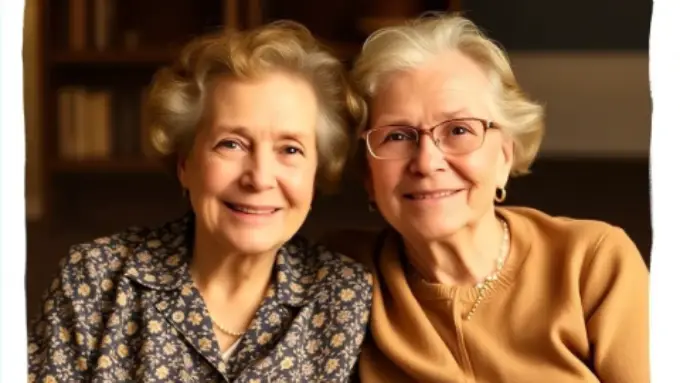The deep, in-person interactions that used to characterize relationships in the past are very different from the way people connect today. These adjustments are quite personal to Sofie Collingsworth since they represent how both her life and the world have changed over time. In addition to detailing her personal path, Sofie provides a perceptive analysis of how human ties have changed and unraveled over time in her book “WHY.”
Sofie’s world in the 1940s was based on sincere, intimate connections. Her early years spent in Cherry Lane were characterized by simplicity; families gathered around dinner tables to share stories rather than screens, and neighbors knew one another by name. Sofie’s relationship with her grandparents was a prime illustration of the closeness that marked these formative years.
Cherry Lane was more than simply Sofie’s house; it was a neighborhood where ties were forged in person and people relied on one another. Sofie’s grandparents acted as pillars in her life, influencing her opinions on the value of interpersonal relationships. Her grandparents’ house was filled with the aroma of freshly baked bread every Sunday when they hosted friends and neighbors for dinner. Eye contact, not emoticons, was the foundation of the laughter, wisdom, and stories that characterized the talks around the table.
Sofie’s relationship with her grandparents went beyond just living together. Whether it was her grandfather teaching her how to mow the lawn with an ancient rotary mower or her grandmother teaching her the craft of traditional baking, she spent her days learning from them. Their relationship was based on time, presence, and mutual respect, and it began with these times of joint action.
Back then, there were no technological distractions or notifications that would draw individuals out of deep conversations. Early relationships formed the foundation of one’s identity, and Sofie’s early years were characterized by the abundance of in-person interactions, a time when love and support were freely given.
Sofie observed the changes in her surroundings as the years went by. New forms of communication were made possible by the introduction of technology, especially in the 1960s and later, but this came at a price. What once needed to be discussed in person might now be completed with a brief phone call or, subsequently, a text message. The fast-paced world that valued convenience above connection started to supplant the sense of community that Sofie had known in Cherry Lane.
Sofie considers this change in the book with a mixture of sadness and nostalgia. She draws a clear contrast between the ease of her childhood and the complexity of today’s world, where interactions between people have been transformed by technology. Numerous individuals, like as Sofie, are pining for the level of intimacy that formerly characterized their lives due to the shift from face-to-face encounters to digital communication.
Sofie grew up in an era where people relied more on one another than on technology. She remembers how going out into the world, having discussions, and forming bonds via common experiences were necessary in order to make new acquaintances or find a mate. However, as technology developed, these exchanges were less intimate, more remote, and generally less satisfying.
How love and friendship have been impacted by this change in social norms is one of “WHY’s” most heartbreaking themes. Sofie’s upbringing in an era where emotional ties were developed gradually and fostered over time had an impact on her relationships, both romantic and platonic. Sofie discovered herself navigating a world growing more isolated as technology took over communication, despite the fact that individuals seemed to be more connected than ever.
This change had an especially big impact on her romance. The shifts in interpersonal relationships had a significant impact on Sofie’s later years, which were characterized by a forbidden love that went against social expectations. Despite being genuine and intense, this love took place in a world where relationships were frequently overshadowed by the fast-paced nature of modern life and the demands of technology.
Sofie considers how her capacity to sustain meaningful relationships was impacted by the shifting times. When she was younger, friendships were based on mutual trust and shared history, and they lasted a lifetime. However, relationships grew increasingly fleeting as civilization evolved, frequently reducing them to brief conversations and surface-level interactions. Sofie began to wonder what had been lost as the depth of friendship and love that had once been the foundation of her existence became harder to discover.
As the story of Sofie’s life progresses, she addresses a subject that will resonate with many readers: the growth of loneliness in a more interconnected society. Sofie and those around her frequently felt more alone, even in spite of technological improvements that made it simpler to stay in touch. In a world where everyone was reachable by phone or message, the depth of relationships that had once provided her happiness and fulfillment was getting harder and harder to sustain, but the real connection seemed unattainable.
Sofie’s observations on loneliness speak to a contemporary audience that faces similar challenges. Many people find themselves yearning for the kind of relationships Sofie had in Cherry Lane—relationships that were based on time, patience, and sincere concern for one another—in a world where social media and instant messaging rule our interactions.
Sofie looks at how technology has led to a paradox of connection in her book. We appear to be more linked than we have ever been on the surface. However, in actuality, a lot of people report feeling more alone and cut off from their surroundings. Sofie’s experience serves as a reminder that although technology can be convenient, it cannot take the place of genuine, in-person friendships for their depth and intimacy.
Though filled with a sense of loss, Sofie’s observations on the shifting social bonds also impart a valuable lesson to contemporary readers. Sofie’s story serves as a reminder that genuine relationships may still be developed in a world where technology rules. Prioritizing time and presence is essential if we want to genuinely connect with the people we care about.
Sofie’s connections with her grandparents in particular show what kind of meaningful, deep relationships are still possible in the modern world. Her narrative implores readers to stand back from the technologically-driven, fast-paced world and make time for the people who really important in their lives. These times of connection, whether they are spent over a meal, engaging in deep conversation, or just hanging out, are what really makes life worthwhile.
For readers, Sofie’s story is a reminder that relationships are worth the effort. The world may have changed, but the value of human connection has not. In a time when it’s easier than ever to send a quick message or make a phone call, Sofie’s life teaches us the importance of slowing down, being present, and nurturing the relationships that bring us joy and fulfillment. The biography of Sofie Collingsworth, as told in “WHY,” offers a compelling analysis of how social ties have changed throughout time. Sofie’s story serves as a reminder of the importance of genuine relationships, despite the differences between her simpler early years in Cherry Lane and the more complicated current existence. In a day where technology frequently rules our interactions, Sofie’s story inspires us to value the relationships that are most important to us and to look for opportunities to get in touch with the people who enrich our lives.


